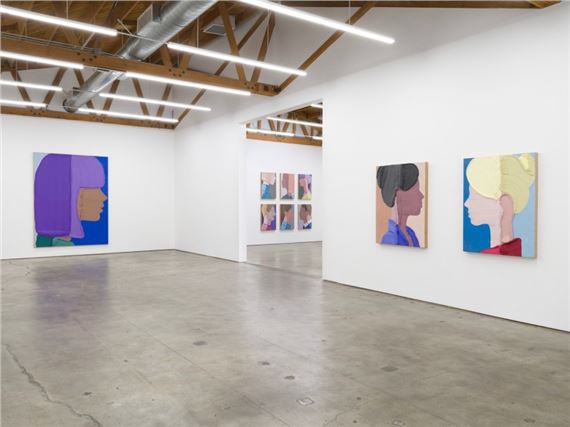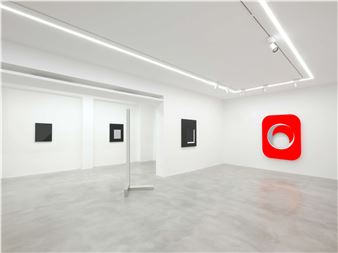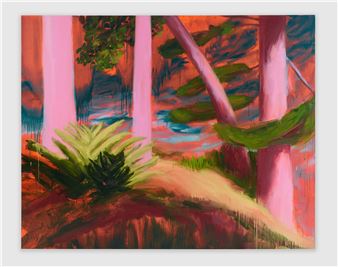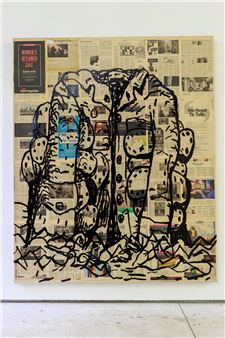Jos├® Lerma: Bayamonesque
In a world where noise and commotion are increasingly prevalent, and where it seems out of fashion to not make one's presence loudly felt, Jos├® Lerma gives a face to the bystanders and the silent witnesses in the back. But only in moderationÔÇöthe faces he presents to us are, after all, stripped down to their most basic features. Highly stylized and rigid, they retain only the bare essentials of facial structure in what the artist calls ÔÇ£the summary of a portrait.ÔÇØ His paintings go beyond mere representation, teetering on the edge of abstraction.
The profile paintings in Bayamonesque are a cornerstone of Jos├® LermaÔÇÖs oeuvre. Over the past decade and a half, since encountering Jean-L├®on G├®r├┤meÔÇÖs ÔÇÿReception of the Grand Cond├® by Louis XIVÔÇÖ at the Mus├®e dÔÇÖOrsay in Paris, he has been captivated by the sparse brushstrokes with which G├®r├┤me rendered background figures. Most of LermaÔÇÖs works are created in a single session. His mediumÔÇöa heavy, unwieldy blend of construction materials and acrylicsÔÇödries quickly, leaving little to no margin for error. The immediacy of his process closely aligns with his goal of capturing the quickness of a sketch.
Though the roots of LermaÔÇÖs ideas lie in the neoclassical and romantic traditions of G├®r├┤me, he also draws inspiration from the sketch-like qualities of the Bay Area Figurative Movement and the work of Belgian artist Bram Bogart. The latter reference comes as no surprise: Bogart, a key figure in informal art, became known for his thick, cement-like canvases. Lerma holds BogartÔÇÖs impasto-rich works in high regard: ÔÇ£Bogart set my blueprint. I just hyper-stylized it.ÔÇØ As with Bogart, so too with LermaÔÇöhis plasticine-like textures evoke an almost primal, childlike urge to reach out and touch their provocative surfaces.
Bayamonesque marks the end of an era. The past fifteen to eighteen years have led to the culmination of this profile series as we know it. Jos├® Lerma sees this body of work as the conclusion of his current artistic cycle, bringing the viewer back to his homeland and the familiar faces of his past to complete this chapter. There are subtle shifts, howeverÔÇöthe skin tones and surface colors now reflect more vivid blues, reds, and greens, lending the figures an otherworldly, almost artificial glow. They seem less illuminated by natural light and more like they exist under an entirely different spectrum.
The title of the exhibition reflects the interplay of opposites, a recurring theme throughout LermaÔÇÖs career. He grew up in Bayam├│n, an industrial suburb on the outskirts of Puerto Rico. Though not known for its picturesque qualities, Bayam├│n holds a special place in the artistÔÇÖs heart, infusing this exhibition with a sense of everyday life. The quotidian nature of his hometown is made poetic by the suffix he adds to it, embodying the incongruity he delights in exploring. The profile paintings, after all, are built on a similar contrastÔÇöbalancing the excess of thick impasto with the sparseness of just a few brushstrokes, and using large canvases to capture what are, essentially, sketches. Then again, the abundance of material makes a Lerma work impossible on a small scale.

Recommended for you
In a world where noise and commotion are increasingly prevalent, and where it seems out of fashion to not make one's presence loudly felt, Jos├® Lerma gives a face to the bystanders and the silent witnesses in the back. But only in moderationÔÇöthe faces he presents to us are, after all, stripped down to their most basic features. Highly stylized and rigid, they retain only the bare essentials of facial structure in what the artist calls ÔÇ£the summary of a portrait.ÔÇØ His paintings go beyond mere representation, teetering on the edge of abstraction.
The profile paintings in Bayamonesque are a cornerstone of Jos├® LermaÔÇÖs oeuvre. Over the past decade and a half, since encountering Jean-L├®on G├®r├┤meÔÇÖs ÔÇÿReception of the Grand Cond├® by Louis XIVÔÇÖ at the Mus├®e dÔÇÖOrsay in Paris, he has been captivated by the sparse brushstrokes with which G├®r├┤me rendered background figures. Most of LermaÔÇÖs works are created in a single session. His mediumÔÇöa heavy, unwieldy blend of construction materials and acrylicsÔÇödries quickly, leaving little to no margin for error. The immediacy of his process closely aligns with his goal of capturing the quickness of a sketch.
Though the roots of LermaÔÇÖs ideas lie in the neoclassical and romantic traditions of G├®r├┤me, he also draws inspiration from the sketch-like qualities of the Bay Area Figurative Movement and the work of Belgian artist Bram Bogart. The latter reference comes as no surprise: Bogart, a key figure in informal art, became known for his thick, cement-like canvases. Lerma holds BogartÔÇÖs impasto-rich works in high regard: ÔÇ£Bogart set my blueprint. I just hyper-stylized it.ÔÇØ As with Bogart, so too with LermaÔÇöhis plasticine-like textures evoke an almost primal, childlike urge to reach out and touch their provocative surfaces.
Bayamonesque marks the end of an era. The past fifteen to eighteen years have led to the culmination of this profile series as we know it. Jos├® Lerma sees this body of work as the conclusion of his current artistic cycle, bringing the viewer back to his homeland and the familiar faces of his past to complete this chapter. There are subtle shifts, howeverÔÇöthe skin tones and surface colors now reflect more vivid blues, reds, and greens, lending the figures an otherworldly, almost artificial glow. They seem less illuminated by natural light and more like they exist under an entirely different spectrum.
The title of the exhibition reflects the interplay of opposites, a recurring theme throughout LermaÔÇÖs career. He grew up in Bayam├│n, an industrial suburb on the outskirts of Puerto Rico. Though not known for its picturesque qualities, Bayam├│n holds a special place in the artistÔÇÖs heart, infusing this exhibition with a sense of everyday life. The quotidian nature of his hometown is made poetic by the suffix he adds to it, embodying the incongruity he delights in exploring. The profile paintings, after all, are built on a similar contrastÔÇöbalancing the excess of thick impasto with the sparseness of just a few brushstrokes, and using large canvases to capture what are, essentially, sketches. Then again, the abundance of material makes a Lerma work impossible on a small scale.
Artists on show
Related articles
When Jose Lerma encountered ÔÇ£Reception of the Grand Cond├® by Louis XIVÔÇØ by Jean-L├®on G├®r├┤me at the Mus├®e dÔÇÖOrsay in Paris, he found himself drawn to the figures tucked far behind the crowd.
The title of the exhibition reflects the interplay of opposites, a recurring theme throughout LermaÔÇÖs career. He grew up in Bayam├│n, an industrial suburb on the outskirts of Puerto Rico.

 ARTISTS
ARTISTS
















